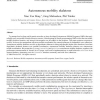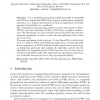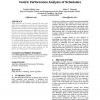628 search results - page 105 / 126 » Tying Memory Management to Parallel Programming Models |
111
Voted
CCGRID
2002
IEEE
15 years 5 months ago
2002
IEEE
Despite the large research efforts in the SW–DSM community, this technology has not yet been adapted widely for significant codes beyond benchmark suites. One of the reasons co...
101
Voted
PC
2006
15 years 10 days ago
2006
To manage load on large and dynamic networks we have developed Autonomous Mobile Programs (AMPs) that periodically use a cost model to decide where to execute. A disadvantage of d...
147
click to vote
HPCA
1996
IEEE
15 years 4 months ago
1996
IEEE
This paper compares several implementations of entry consistency (EC) and lazy release consistency (LRC), two relaxed memory models in use with software distributed shared memory ...
109
Voted
FGCS
2006
15 years 12 days ago
2006
Tw o parallel programming models represented b y OpenMP and MPI are compared for PDE solvers based on regular sparse numerical operators. As a typical representative of such an app...
105
Voted
HPDC
2007
IEEE
15 years 6 months ago
2007
IEEE
Utility functions can be used to represent the value users attach to job completion as a function of turnaround time. Most previous scheduling research used simple synthetic repre...



